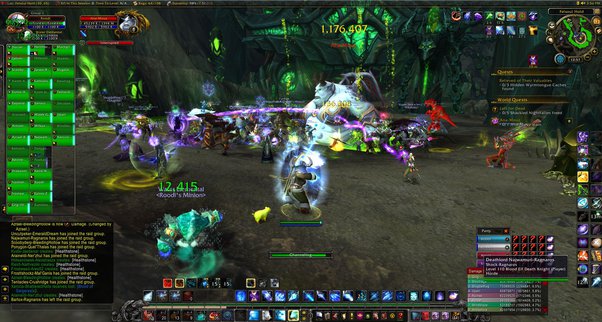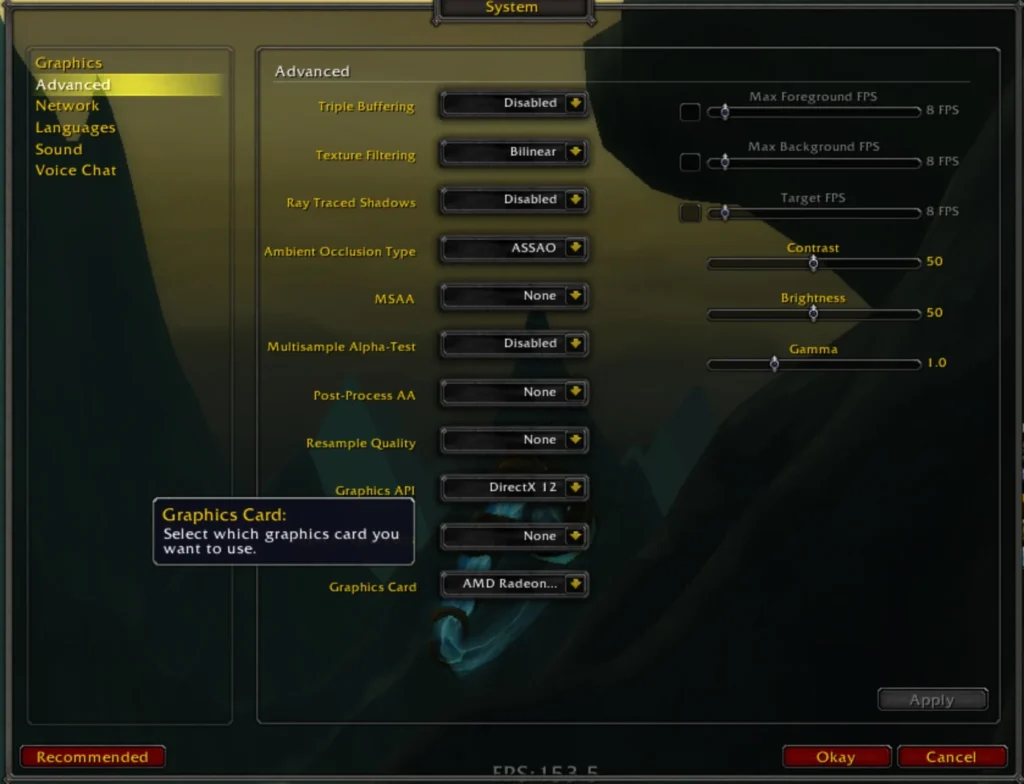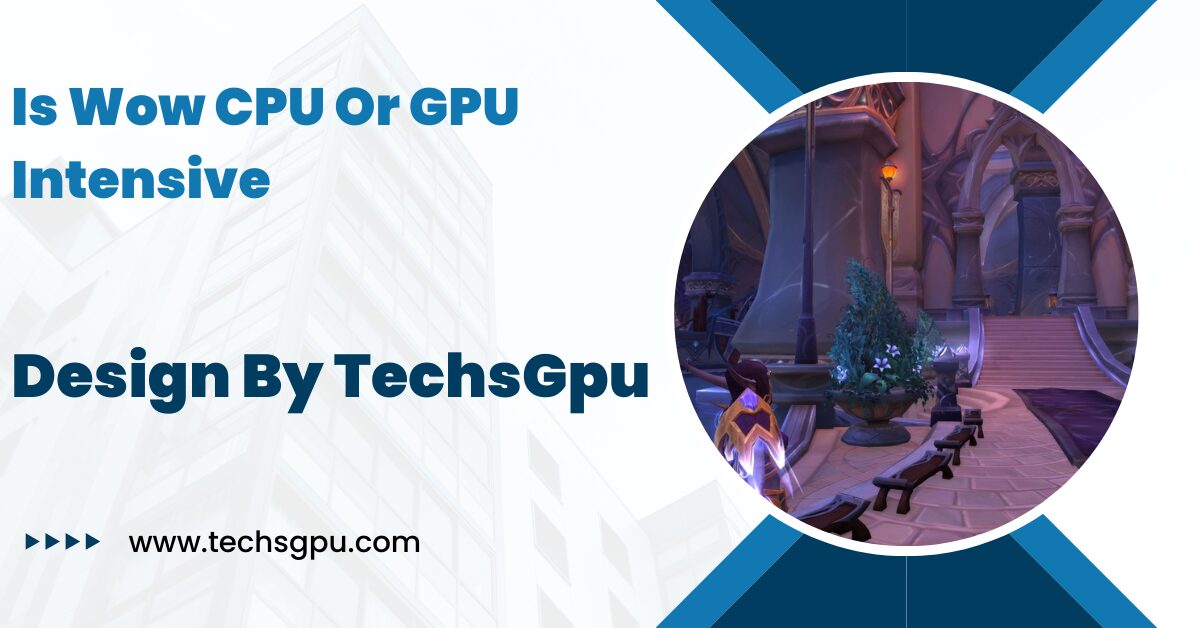World of Warcraft (WoW) predominantly relies on the CPU for handling game logic, NPC interactions, and player actions, although a capable GPU is also essential for rendering high-resolution graphics and visual effects.
Introduction:
World of Warcraft (WoW) is a massively popular MMORPG that has captivated gamers for over a decade. With its expansive world, intricate quests, and dynamic multiplayer experiences, many players wonder about the hardware demands of running the game smoothly.
Specifically, is WoW more CPU or GPU intensive? This article aims to provide a detailed analysis to help you optimize your gaming setup for the best WoW experience.
Understanding WoW’s System Requirements:

To understand whether WoW is more CPU or GPU intensive, it’s essential to know its system requirements. WoW’s minimum requirements include an Intel Core i5-3450 or AMD FX 8300 CPU, an NVIDIA GeForce GTX 760 or AMD Radeon RX 560 GPU, and 4 GB of RAM, with an SSD recommended for storage.
The recommended specs are more robust, suggesting an Intel Core i7-6700K or AMD Ryzen 7 2700X CPU, an NVIDIA GeForce GTX 1080 or AMD Radeon RX Vega 64 GPU, and 8 GB of RAM, also with an SSD for optimal performance. These requirements provide a baseline, but understanding the role of each component is key.
CPU vs. GPU: What Does WoW Rely On?
The CPU is the brain of your computer, handling most of the game’s logic, including NPC behaviors, quest computations, and overall game mechanics. WoW’s extensive quests, NPC interactions, and player actions require significant CPU power to process and manage.
Additionally, WoW can benefit from multi-core processors, improving performance during raids and in crowded areas. Many WoW players use add-ons to enhance their gameplay, which can further tax the CPU, especially if multiple add-ons are running simultaneously.
The GPU handles rendering the game’s graphics, including textures, shadows, lighting, and other visual effects. Detailed environments and character models need a powerful GPU to look their best.
Spells, shadows, and lighting effects are GPU intensive, requiring a robust GPU to maintain smooth performance. Playing WoW at ultra settings or on a 4K monitor requires a powerful GPU to ensure a fluid gaming experience.
CPU-Intensive Scenarios in WoW:
In large-scale raids and player versus player (PvP) scenarios, the CPU is heavily utilized. Each player action, spell cast, and NPC movement must be processed in real-time, creating a significant load on the CPU.
Higher clock speeds and more cores can help manage this load effectively. Cities and popular gathering spots, like Orgrimmar or Stormwind, can see hundreds of players in the same area.
The CPU must handle all the interactions and movements, leading to increased CPU usage. An efficient CPU ensures smoother gameplay in these crowded environments.
Also Read: Is My GPU Compatible With My Motherboard – A Comprehensive Guide!
GPU-Intensive Scenarios in WoW:
While WoW is more CPU dependent, the GPU still plays a critical role, especially at higher settings. Increasing graphical settings such as view distance, texture resolution, and shadow quality puts more strain on the GPU.
Running WoW at higher resolutions, like 1440p or 4K, requires a capable GPU to maintain a high frame rate. WoW features numerous special effects, especially during intense battles with spells and abilities being cast frequently.
These visual elements are GPU intensive, and a robust GPU ensures that these effects render smoothly without dropping frames.
Benchmarking WoW – CPU vs. GPU Performance!
To better understand how WoW utilizes the CPU and GPU, let’s look at some benchmarking data from various hardware configurations. Benchmarks typically measure frame rates (FPS) under different scenarios, providing insights into which component is under more load.
An Intel Core i5-9600K paired with an NVIDIA GTX 1660 Ti shows that the CPU can handle most scenarios comfortably. However, in high-population areas or large-scale raids, the FPS can dip slightly, indicating a need for a more powerful CPU.
An Intel Core i9-9900K paired with an RTX 2080 Super shows excellent performance, maintaining high FPS even in the most demanding situations. An NVIDIA GTX 1660 Ti paired with an Intel Core i5-9600K performs well at medium to high settings.
However, at ultra settings or higher resolutions, the FPS may drop, suggesting the need for a more powerful GPU. An RTX 2080 Super paired with an Intel Core i9-9900K handles ultra settings and high resolutions effortlessly, maintaining a smooth gaming experience.
Optimizing WoW Performance:

For WoW players experiencing lag or low FPS, upgrading to a modern, multi-core CPU can significantly improve performance. CPUs with higher clock speeds and more cores can handle the game’s demands more efficiently.
While not as critical as the CPU, a good GPU ensures you can enjoy WoW’s visual splendor. Investing in a mid-to-high range GPU allows you to play at higher settings and resolutions without sacrificing performance. WoW benefits greatly from faster load times with an SSD.
An SSD can reduce loading times when entering new zones, logging in, or loading instances, providing a smoother overall experience. Tweaking settings like view distance, shadows, and particle effects can relieve some GPU stress. Lowering these settings slightly can result in a significant performance boost without drastically affecting visual quality.
Some add-ons can be CPU hogs. Regularly updating or disabling unnecessary add-ons can help maintain performance. Ensure that you only use essential add-ons and keep them optimized.
Additional Tips for Optimizing WoW:
Keeping Drivers Updated:
Ensuring that your GPU drivers are up to date can provide performance enhancements and fix bugs. Manufacturers like NVIDIA and AMD regularly release updates that optimize game performance.
Managing Background Processes:
Close unnecessary background processes and applications to free up system resources. This can help your CPU and GPU focus on running WoW more efficiently.
Cooling Solutions:
Maintaining optimal temperatures for your CPU and GPU is crucial for performance. Invest in good cooling solutions to prevent thermal throttling, which can reduce performance.
Also Read: Is BeamNG Cpu or Gpu Intensive – Ultimate Guide to BeamNG.drive Performance!
Hardware Recommendations for WoW Players:
If you’re looking to upgrade your system for WoW, consider a balanced approach. A powerful, multi-core CPU like the Intel Core i7-9700K or AMD Ryzen 5 5600X can handle WoW’s demands effectively.
Pair it with a mid-to-high range GPU such as the NVIDIA GeForce RTX 3060 or AMD Radeon RX 6700 XT for a smooth gaming experience at higher settings.
Additionally, ensure you have at least 8 GB of RAM, with 16 GB being ideal for multitasking and running additional applications.
FAQs:
1. What are WoW’s minimum system requirements?
WoW requires at least an Intel Core i5-3450 or AMD FX 8300 CPU, NVIDIA GeForce GTX 760 or AMD Radeon RX 560 GPU, 4 GB of RAM, and an SSD for optimal performance.
2. Is WoW more CPU or GPU intensive?
WoW leans more towards being CPU intensive due to its need to handle game logic, NPC behaviors, and player actions, especially in crowded areas.
3. What role does the GPU play in WoW?
While WoW is CPU dependent, the GPU handles rendering tasks such as textures, shadows, and special effects. A powerful GPU is essential for high graphical settings and resolutions.
4. How can I optimize WoW performance?
Upgrading to a modern, multi-core CPU and a mid-to-high range GPU can significantly improve WoW’s performance. Additionally, optimizing in-game settings and managing add-ons can help enhance gameplay.
5. What hardware should I consider for playing WoW at high settings?
For optimal performance in WoW, consider a powerful CPU like the Intel Core i7-9700K or AMD Ryzen 5 5600X, paired with a mid-to-high range GPU such as the NVIDIA GeForce RTX 3060 or AMD Radeon RX 6700 XT, and at least 8 GB of RAM.
Conclusion:
World of Warcraft places heavier demands on the CPU for processing game logic and managing interactions, making it primarily CPU intensive. However, a capable GPU is also crucial, particularly for handling high-resolution textures and visual effects. By understanding these hardware demands and optimizing your system accordingly, you can ensure a smooth and immersive gaming experience in WoW.
